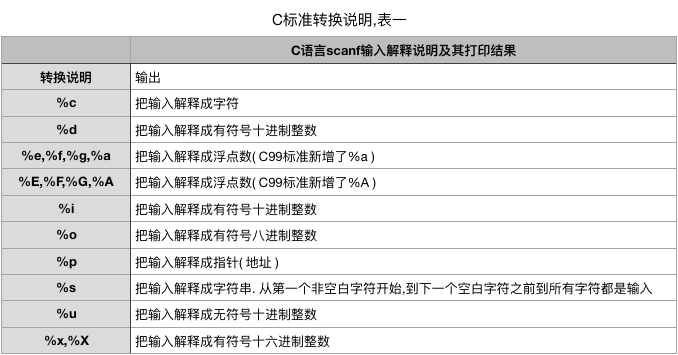1. 对于上一篇文章,总结printf()输出,C库也包含了多个输入函数, scanf()是最常用的一个,也是经常与printf()经常一起搭配使用的函数之一.
scanf()和printf()类似, 也是使用格式字符串和参数列表. scanf中的格式字符串表明字符输入流的目标整数类型.两个函数主要的区别在参数列表中. printf()函数使用变量, 常量和表达式, 而scanf()函数使用指向变量的指针, 指针将在后续学习中总结. 使用scanf()有一下两个规则:
1⃣️ 如果用scanf()读取基本变量类型的值, 在变量名前加上一个&;
2⃣️ 如果用scanf()把字符串读入字符串数组中, 不要使用&.
举例一:
#include <stdio.h> int main(int argc, const char * argv[]) { int age; float assets; char per[30]; printf("Enter your age,assets,and favorite "); scanf("%d",&age); scanf("%f",&assets); scanf("%s",per); printf("%d, $%.2f %s ",age,assets,per); return 0; }
打印结果
Enter your age,assets,and favorite 27 43.25 apple 27, $43.25 APPLE Program ended with exit code: 0
2. 总结完基本规则, 我们先把列表转换说明附上
ANSI C 中scanf基本转换说明

ANSI C 中scanf转换说明修饰符

3. 从scanf() 角度看输入
假设scanf()根据一个%d转换说明读取一个整数. scanf()函数每次读取一个字符, 跳过所有的空白字符, 直至遇到第一个非空白字符才开始读取. 因为要读取整数, 所以scanf()希望发现一个数字字符或者一个符号(+或-).如果遇到一个数字或符号, 它便保存该字符, 并读取下一个字符. 如果下一个字符是数字, 它便保存该数字并读取下一个数字. scanf()不断第读取和保存, 直到遇到非数字字符. 如果读取到一个非数字字符, 它便认为读到了整数的末尾. 然后,scanf()把非数字字符放回输入. 这意味着程序在下一次读取输入时, 首先读到的是上一次丢弃的非数字字符. 最后, scanf()计算已读取数字(可能)相应的数值, 并将计算后值放入指定的变量中.
示例二:
#include <stdio.h> int main(int argc, const char * argv[]) { int age; char name[40]; scanf("%d",&age); scanf("%s",name); printf("%d,and %s ", age,name); return 0; }
打印结果
78 wuhan 78,and wuhan Program ended with exit code: 0
4. 如果使用字段宽度, scanf()会在字段结尾或第一个空白字符处停止读取( 满足两个条件之一就停止)
#include <stdio.h> int main(int argc, const char * argv[]) { char name[40]; scanf("%10s",name); printf("%s ",name); return 0; }
在运行中输入 ‘wuhanHangzShanghai’,打印结果
wuhanHangz
5 如果使用%s转换说名, scanf()会读取除空白以外的所有字符. scanf()跳过空白字符开始读取第一个字符非空白字符. 并保存非空白字符直到遇到空白字符. 这意味这scanf()根据%s转换说明读取i一个单词, 即不包含空白字符的字符串.
如果使用字段宽度, scanf() 在字段末尾或者第一个空白字符处停止读取. 无法利用字段宽度让只有一个%s的scanf()读取多个单词. 最后注意一点: 当scanf()把字符串放进指定数组中时, 它会在字符序列末尾加上‘�’, 让数组中的内容成为一个C字符串.
6 scanf()的返回值
scanf()函数返回成功读取的项数. 如果没有读取到如何项, 且需要读取一个数字而用户却输入一个非数字字符串, scanf()返回0.
当scanf() 检测到‘文件结尾’时, 会返回EOF (EOF是stdio.h中定义的特殊值, 通常用#define 指令把EOF定义为-1)
示例三:
#include <stdio.h> int main(int argc, const char * argv[]) { int n1,n2,n3,m1,m2,s,num; m1 = scanf("%d",&n1); m2 = scanf("%d %d",&n2,&n3); s = scanf("%d",&num); printf("Enter number n1 = %d, n2 = %d, n3 = %d,num = %d ",n1,n2,n3,num); printf("scanf return m1 = %d, m2 = %d, s = %d ",m1,m2,s); return 0; }
输入‘12 45 678 string’, 打印结果
12 45 678 string Enter number n1 = 12, n2 = 45, n3 = 678,num = 0 scanf return m1 = 1, m2 = 2, s = 0 Program ended with exit code: 0
7 printf() 和 scanf() 的*修饰符
printf() 和 scanf() 都可以使用8修饰符来修改转换说明都含义. 但是, 他们都用法不太一样.
如果你不想预先设定指定字段宽度, 希望通过程序来指定, 那么可以用*修饰符代替字段宽度. 但还是要用一个参数告诉函数, 字段宽度应该是多少. 也就是说转换说明是%*d, 那么参数列表中应包含*和d对应都值. 这个技巧也可应用于浮点值指定精度和字段.
示例四:
#include <stdio.h> int main(int argc, const char * argv[]) { unsigned width,precision; int number = 20; double weight = 242.5; printf("Enter a field "); scanf("%d",&width); printf("The number is :%*d ",width,number); printf("Now enter a width and a precision: "); scanf("%d %d",&width,&precision); printf("Weight = %*.*f. ",width,precision,weight); printf("Done "); return 0; }
打印结果
Enter a field 12 // 输入 The number is : 20 Now enter a width and a precision: 30 6 // 输入 Weight = 242.500000. Done Program ended with exit code: 0
scanf()中的*用法与此不同, 把*放在%和转换说明符之间,会使得scanf()跳过相应的输出项.
示例五:
#include <stdio.h> int main(int argc, const char * argv[]) { int n; printf("Please enter three integers: "); scanf("%*d %d %*d",&n); printf("The last integer was %d ",n); return 0; }
打印结果
Please enter three integers:
12 23 45 // 输入
The last integer was 23
Program ended with exit code: 0
示例六
int main(int argc, const char * argv[]) { int n; printf("Please enter three integers: "); scanf("%*d %*d %d",&n); printf("The last integer was %d ",n); return 0; }
打印结果
Please enter three integers: 65 78 967 // 输入 The last integer was 967 Program ended with exit code: 0